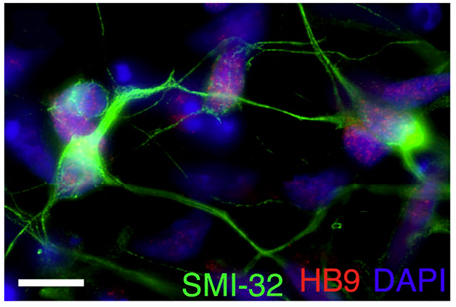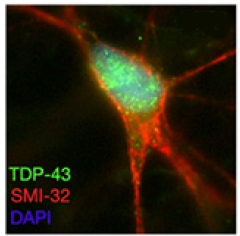
Lights camera action potential. Scientists recreated diseased motor neurons by reprogramming skin cells from a person with a rare inherited form of ALS linked to a mutation in TDP-43. Adapted from Bilican, B et al. (2012). Courtesy of the National Academy of Sciences Press. All rights reserved.
For more than 150 years, ALS has been recognized by experts as a motor neuron disease. But scientists still remain unsure why these cells are especially vulnerable to destruction in people with ALS or why they ultimately fail during the course of the disease.
An international group of neuroscientists led by University of Edinburgh’s Siddharthan Chandran MD PhD, King’s College London’s Christopher Shaw MBChB MD FRACP FRCP and Columbia University’s Tom Maniatis PhD hopes to begin to answer these questions by recreating ALS-ravaged motor neurons in laboratory dishes and studying their neurodegeneration.
Now, the UK-US research team reports that they have hit their first milestone: the generation of a so-called induced pluripotent stem (iPS) cell line created from an ALS patient skin biopsy that can be used to cook up motor neurons in the laboratory. Incredibly, the motor neurons induced appear to be in working order - capable of firing electrical signals used to 'tell' muscles to move - and exhibit tell-tale signs of the disease.
This is the first time that researchers have been able to recreate apparently functional motor neurons in the laboratory from a person with ALS.
The study is published this month in the Proceedings of the National Academy of Sciences.

Not an exact match. Researchers discovered that induced ALS motor neurons accumulate misfolded TDP-43 (green). But unlike more than 90% of people with ALS, these aggregates do not build up in the cytoplasm. Image: Bilican, B et al. (2012). Courtesy of the National Academy of Sciences Press. All rights reserved.
The UK-US research team created a 'line' of ALS iPS cells by turning back the cellular clocks of a patient's skin cells and culturing them. The scientists then splashed these iPS cells with a few chemicals to push them into motor neuronal mode.
Peering under the microscope, the researchers found that the resulting motor neurons somewhat resembled those in people with ALS. The cells were nearly 3-times more prone to degeneration. And, misfolded proteins accumulated in them.
Meanwhile, neuroscientists at Nationwide Children’s Hospital in Ohio hope to up the ante by introducing key inflammation instigators such as microglia and astrocytes into the mix to truly recreate ALS in laboratory dishes. Just last September, the research team led by neuroscientist Brian Kaspar PhD reported the successful reconstitution, using spinal cord tissue from ALS patients, of a key aspect of astrocytosis – the astrocyte-mediated destruction of neighboring motor neurons - which in part fuels the progression of the disease.
Looking ahead, these cellular systems could help scientists uncover underlying mechanisms of ALS and at the same time, pave the way toward the development of personalized therapies to treat the disease.
To find out more about how scientists hope to use stem cells to better understand why motor neurons degenerate in people with ALS, read Dishing ALS.
References
Bilican, B. et al. (2012) Mutant induced pluripotent stem cell lines recapitulate aspects of TDP-43 proteinopathies and reveal cell-specific vulnerability. Proceedings of the National Academy of Sciences, doi:10.1073/ pnas.1202922109. Abstract | Full Text (Open Access)
Haidet-Phillips, A.M. et al. (2011) Astrocytes from familial and sporadic ALS patients are toxic to motor neurons. Nature Biotechnology, 29(9), 824-8. Abstract | Full Text (Subscription Required)
Further Reading
Son, E.Y., Ichida, J.K., Wainger, B.J., Toma, J.S., Rafuse, V.F., Woolf, C.J. and Eggan, K. (2011). Conversion of mouse and human fibroblasts into functional spinal motor neurons. Cell Stem Cell, 9(3), 205-218. Abstract | Full Text (Open Access)
Dimos, J.T. et al. (2008) Induced pluripotent stem cells generated from patients with ALS can be differentiated into motor neurons. Science 321, 1218-1221. Abstract | Full Text (Subscription Required)
Di Giorgio, F.P., Boulting, G.L., Bobrowicz, S., and Eggan, K.C. (2008). Human embryonic stem cell-derived motor neurons are sensitive to the toxic effect of glial cells carrying an ALS-causing mutation. Cell Stem Cell, 3(6), 637-648. Abstract | Full Text (Subscription Required)
Marchetto, M.C., Muotri, A.R., Mu, Y., Smith, A.M., Cezar, G.G., and Gage F.H. (2008). Non-cell-autonomous effect of human SOD1 G37R astrocytes on motor neurons derived from human embryonic stem cells. Cell Stem Cell, 3(6), 649-657. Abstract | Full Text (Subscription Required)